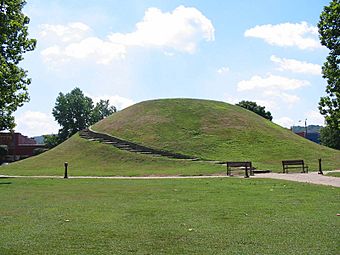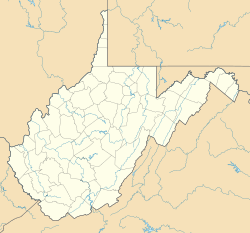Criel Mound facts for kids
Quick facts for kids |
|
|
South Charleston Mound
|
|

The Criel Mound
|
|
| Location | US 60 (MacCorkle Avenue), in city park, South Charleston, West Virginia |
|---|---|
| Area | 1.5 acres (0.61 ha) |
| NRHP reference No. | 70000655 |
| Added to NRHP | October 15, 1970 |
The Criel Mound, also called the South Charleston Mound, is an ancient Native American burial mound. It's located in South Charleston, West Virginia. This mound is one of the few left from a group called the Kanawha Valley Mounds. These mounds were likely built during the Woodland period, after 500 BC.
The Adena culture built the Criel Mound, probably around 250–150 BC. It was placed exactly between two large "sacred circles." These were earthwork enclosures, each about 556 feet (169 m) across. The Criel Mound was originally 33 feet (10 m) high and 173 feet (53 m) wide at its base. This makes it the second-largest burial mound in West Virginia. The Grave Creek Mound in Moundsville is the biggest. This important archaeological site is listed on the National Register of Historic Places.
Discovering the Criel Mound's Past
The Criel Mound was once shaped like a cone. In 1840, local people flattened its top. They did this to build a judges' stand for horse races. These races were held around the base of the mound.
Exploring Inside the Mound
From 1883 to 1884, scientists carefully dug into the Criel Mound. This work was led by Col. P.W. Norris and Professor Cyrus Thomas from the Smithsonian Institution. They found thirteen skeletons inside the mound. Two skeletons were near the top. The other eleven were at the very bottom.
At the base, there was one very large skeleton in the center. It was badly decayed but seemed to be from a "once most powerful man." A person helping with the dig said it measured "Six feet, 8 3–4 inches" (205 cm) tall. Ten other skeletons were placed around this central one. Their feet pointed toward the large skeleton, like spokes on a wheel.
These skeletons at the bottom were wrapped in elm bark. They lay on a floor made of white ash and bark. The scientists also found several ancient items buried with them. These included arrowheads, lanceheads, and pieces of shell and pottery. Near the head of the central skeleton, they found a fish-dart, a lance-head, and a thin sheet of hammered native copper. Holes found at the mound's base suggest the bodies were placed inside a wooden room or vault.
The Kanawha Valley Mounds
The Criel Mound is part of a large group of Adena mounds and circular enclosures. Professor Cyrus Thomas called this area the "Kanawha Valley Mounds." It's the second-largest collection of such sites known. This area stretches for eight miles (13 km) along the Kanawha River floodplain. It's near where Charleston is today.
In 1894, Cyrus Thomas reported finding 50 mounds in this area. They ranged from 3 to 35 feet high and 35 to 200 feet wide. He also found eight to ten circular earthworks. These enclosures covered from 1 to 30 acres (120,000 m2) of land. Stone mounds were also found on the hills above the river valley.
Many of the original Adena mounds were destroyed as the area developed. However, a few still remain. The Wilson Mound is in a private cemetery in South Charleston. The Shawnee Reservation Mound can still be seen in Institute, West Virginia.
Criel Mound Today: Staunton Park
Today, the Criel Mound is the main feature of Staunton Park. This is a small park managed by the city of South Charleston. It's a popular spot for community events. People gather there for arts and crafts fairs, music events, memorial services, and town carnivals.



